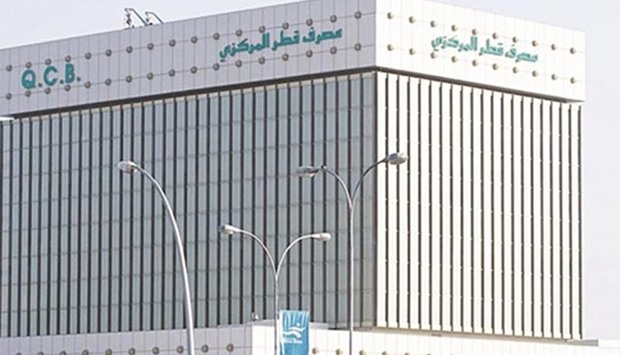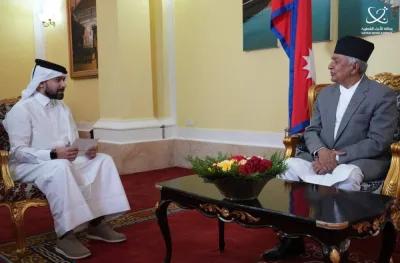In a press release on Thursday, QCB also announced an increase in its overnight deposit rate by 25 basis points to 1.25%.
The increase in both the overnight lending rate and overnight deposit rate took effect on Thursday.
However, QCB reduced the banks’ required reserve ratio - the amount of money they must hold back from lending as reserves - from 4.75% to 4.5%, with effect from April 1.
“The reserve requirement cut followed complaints by commercial banks about tight liquidity in the money market, which has driven short-term market rates up sharply in the past 18 months. The reserve requirement was last changed in April 2008,” a Reuters’ dispatch showed.
Consequent on the QCB rate hike, the local banks are expected to increase both their lending and deposit rates shortly. Customers may be notified on the rate revision over the coming days.
In a recent report, BMI Research said although vast fiscal buffers meant Qatar was able to defend the peg in the event of a narrowing interest rate differential with the US, it believed the hike would be enacted without delay, as rising energy prices and preparations for the 2022 FIFA World Cup boost Qatari economic growth and moderately increase inflationary pressures, while domestic liquidity pressures ease.
Given the riyal’s peg to the dollar, BMI, a Fitch Group company, expects the QCB to continue tracking the US Fed’s monetary tightening cycle in the coming years.
The central bank raised its overnight lending rate from 4.5% to 4.75% and deposit rate from 0.75% to 1% in mid-December 2016, shortly after the US Fed announced it would hike its benchmark interest rate by 25 bps.
Qatar’s vast foreign reserves, enough to cover 6.6 months of imports as of January, mean that the QCB would be able to defend the riyal’s dollar peg should the interest differential reduce.
Qatar’s international reserves picked up to $33.8bn in January from $31.6bn in December, QNB has said in a new report.
In terms of months of import cover, this “recovered” to 6.6 months from 6.1 months previously, well above the IMF recommended minimum of three months for a fixed-exchange rate regime, QNB's latest ‘Monthly Monitor’ showed.
“We, nevertheless, do not expect a delay in the hike, as rising energy prices spur a pickup in Qatari economic activity and inflation over 2017, and as domestic liquidity pressures - illustrated by the rise in the three-month Qatar interbank rate and M2 money supply contraction lessen. This will broadly remain the trend over the coming years, despite our forecast for acceleration in the QCB policy rate hiking cycle in 2018 and 2019,” when BMI expects the US Fed to raise its funds rate by 50bps and 75bps, respectively.
BMI expects Qatar to see a moderate acceleration in inflation over the coming quarters, as global energy prices tick up and government efforts to diversify its revenue base continue. A BMI team forecasts Brent prices to average $57 per barrel and $60 in 2017 and 2018 respectively - significantly higher than the $45-level recorded over 2016.
With domestic petrol and diesel prices linked to global markets since May 2016, this will add to inflationary pressures in the country.
Furthermore, the government has announced plans to introduce taxes on goods deemed ‘harmful to human health and the environment’ (including, from 2017, tobacco and sugary drinks) and on ‘selected’ luxury items.
Qatar will also implement a GCC-wide value-added tax (VAT) over 2018 - though BMI expects the inflationary impact of this measure to be relatively limited, given its small size (5%) and the fact that many food items and essential services (such as education) will be exempt.
The increase in both the overnight lending rate and overnight deposit rate took effect on Thursday.
However, QCB reduced the banks’ required reserve ratio - the amount of money they must hold back from lending as reserves - from 4.75% to 4.5%, with effect from April 1.
“The reserve requirement cut followed complaints by commercial banks about tight liquidity in the money market, which has driven short-term market rates up sharply in the past 18 months. The reserve requirement was last changed in April 2008,” a Reuters’ dispatch showed.
Consequent on the QCB rate hike, the local banks are expected to increase both their lending and deposit rates shortly. Customers may be notified on the rate revision over the coming days.
In a recent report, BMI Research said although vast fiscal buffers meant Qatar was able to defend the peg in the event of a narrowing interest rate differential with the US, it believed the hike would be enacted without delay, as rising energy prices and preparations for the 2022 FIFA World Cup boost Qatari economic growth and moderately increase inflationary pressures, while domestic liquidity pressures ease.
Given the riyal’s peg to the dollar, BMI, a Fitch Group company, expects the QCB to continue tracking the US Fed’s monetary tightening cycle in the coming years.
The central bank raised its overnight lending rate from 4.5% to 4.75% and deposit rate from 0.75% to 1% in mid-December 2016, shortly after the US Fed announced it would hike its benchmark interest rate by 25 bps.
Qatar’s vast foreign reserves, enough to cover 6.6 months of imports as of January, mean that the QCB would be able to defend the riyal’s dollar peg should the interest differential reduce.
Qatar’s international reserves picked up to $33.8bn in January from $31.6bn in December, QNB has said in a new report.
In terms of months of import cover, this “recovered” to 6.6 months from 6.1 months previously, well above the IMF recommended minimum of three months for a fixed-exchange rate regime, QNB's latest ‘Monthly Monitor’ showed.
“We, nevertheless, do not expect a delay in the hike, as rising energy prices spur a pickup in Qatari economic activity and inflation over 2017, and as domestic liquidity pressures - illustrated by the rise in the three-month Qatar interbank rate and M2 money supply contraction lessen. This will broadly remain the trend over the coming years, despite our forecast for acceleration in the QCB policy rate hiking cycle in 2018 and 2019,” when BMI expects the US Fed to raise its funds rate by 50bps and 75bps, respectively.
BMI expects Qatar to see a moderate acceleration in inflation over the coming quarters, as global energy prices tick up and government efforts to diversify its revenue base continue. A BMI team forecasts Brent prices to average $57 per barrel and $60 in 2017 and 2018 respectively - significantly higher than the $45-level recorded over 2016.
With domestic petrol and diesel prices linked to global markets since May 2016, this will add to inflationary pressures in the country.
Furthermore, the government has announced plans to introduce taxes on goods deemed ‘harmful to human health and the environment’ (including, from 2017, tobacco and sugary drinks) and on ‘selected’ luxury items.
Qatar will also implement a GCC-wide value-added tax (VAT) over 2018 - though BMI expects the inflationary impact of this measure to be relatively limited, given its small size (5%) and the fact that many food items and essential services (such as education) will be exempt.




